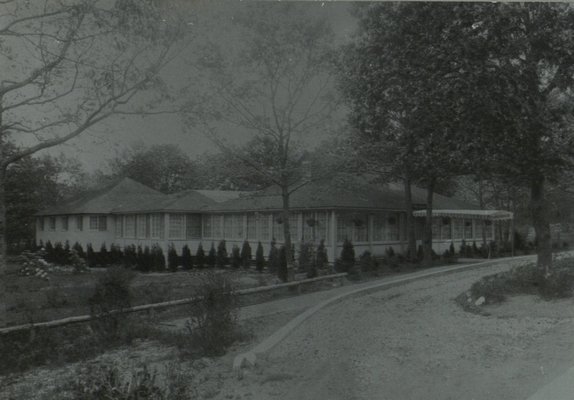
The space at 103 Montauk Highway, whose owners are seeking a special permit before the East Hampton Village ZBA, is deeply rooted in food culture and history throughout the past 90 years, having operated as a restaurant, nightclub and, for a short period of time, a theater.
“That space has always reflected whatever the trend of the decade was,” said ZBA Chairman Frank E. Newbold in an interview on Tuesday. “It’s interesting—I feel like it was always a reflection of what the locals were up to and interested in, until more recently.”
The building dates back to the 1920s, according to Village Building Inspector Ken Collum, when it opened as The Oaks Inn, a popular nightspot, according to documents from the East Hampton Library, and stood just west of what was once the Sag Harbor Savings Bank on Montauk Highway. However, it did not have a liquor license until 1953, according to a legal announcement in The East Hampton Star.
“The property became part of the village in 1948, when it was annexed and zoned for residential,” according to a letter to the ZBA from Dan Voorhees, the village attorney in the 1970s. “At that time, it was called The Oaks.”
The restaurant continued to operate under the name The Oaks Inn, owned by Fred Blumenthal, in the 1950s and 1960s. It was well known for housing parties for organizations like the East Hampton Fire Department, according to another story in The East Hampton Star from 1954. Mr. Blumenthal hosted parties “in his usual excellent style,” including annual high school football dinners, and local choruses.
From 1972 until 1976, The Moon took up shop at 103 Montauk Highway. However, the property’s ownership at that time is unclear. A favorite of ZBA Co-Chair Lys Marigold and ZBA Chairman Frank Newbold, The Moon was “dark and moody, and the place to be seen late, late at night,” said Ms. Marigold.
Mr. Newbold said The Moon was “like the country version of the big-deal discos in New York.”
“It was probably pretty sad by comparison,” he laughed, “but at the time it was a big deal. You’d show up late, and there’d just be endless Donna Summer songs.”
After The Moon, the space turned into Butterfield II until the late 1970s, before changing again to 411 East, according to ZBA documents. However, neither Mr. Newbold nor Ms. Marigold remembered either business. 411 East, according to an application on file at Village Hall, was the sister spot of a trendy Manhattan restaurant, 411 West, but lasted only a few seasons before becoming the Royale Fish Restaurant in 1981.
Royale Fish was owned by Sue Feleppa, a Corcoran real estate agent, and had another space in Amagansett, according to Corcoran’s website. In its early stages, the restaurant also had a theater, but Ms. Feleppa and her husband did away with the performance portion of the business in 1984, according to an article in The New York Times.
“The Royale Fish has an airy, attractively casual summertime appeal, done in white, softly lit by hanging industrial lamps, decorated with some well-chosen country pieces and dressed up with informal floral sprays,” wrote New York Times restaurant critic Florence Fabricant in her 1984 story.
In 1985, The Royale Fish turned into Little Rock Rodeo, a “Tex-Mex” style restaurant when “fajitas were all the rage,” said Mr. Newbold.
“Fajitas are the main attraction,” Ms. Fabricant wrote in a 1985 review for The Times. “Strips of tender beef or boneless chicken are grilled over mesquite, mingled with grilled onions and served with an assortment of condiments to roll into flour tortillas. They come to the table sizzling, a theatrical effect heightened by the splash of fresh lemon juice they receive just before being served.”
Throughout the 1990s, 103 Montauk Highway was home to Duke’s, a “not Tuscan, not French and certainly not haute anything” spot, according to a review in The Times, and Bacci’s Charcoal Haven, and later Peconic Coast into the late 1990s.
In the early 2000s, Ed “Jean-Luc” Kleefield—then the owner of Madame Tong’s in Southampton Village, Grappa and JLX Bistro in Sag Harbor—opened JL East in the space. In 2007, Mr. Kleefield turned the space into Prime 103, a steakhouse, before morphing it into Lily Pond, a clubby destination for 20-somethings that later moved to Three Mile Harbor Road.
In 2011, the restaurant became Beachhouse, a sister restaurant to the Manhattan joint Boathouse, but that lasted only a season. In 2012, Beachhouse turned to The Players Club, a polo-inspired lounge, which went out of business the following year.
The space has remained empty since.
“It’s the end of an era,” said Mr. Newbold. “It was a restaurant since the ’20s, and at the end, when it tried to go over the top with becoming these places that catered to vacationers, it really went over the top,” he said of the most recent, rapid change of hands.